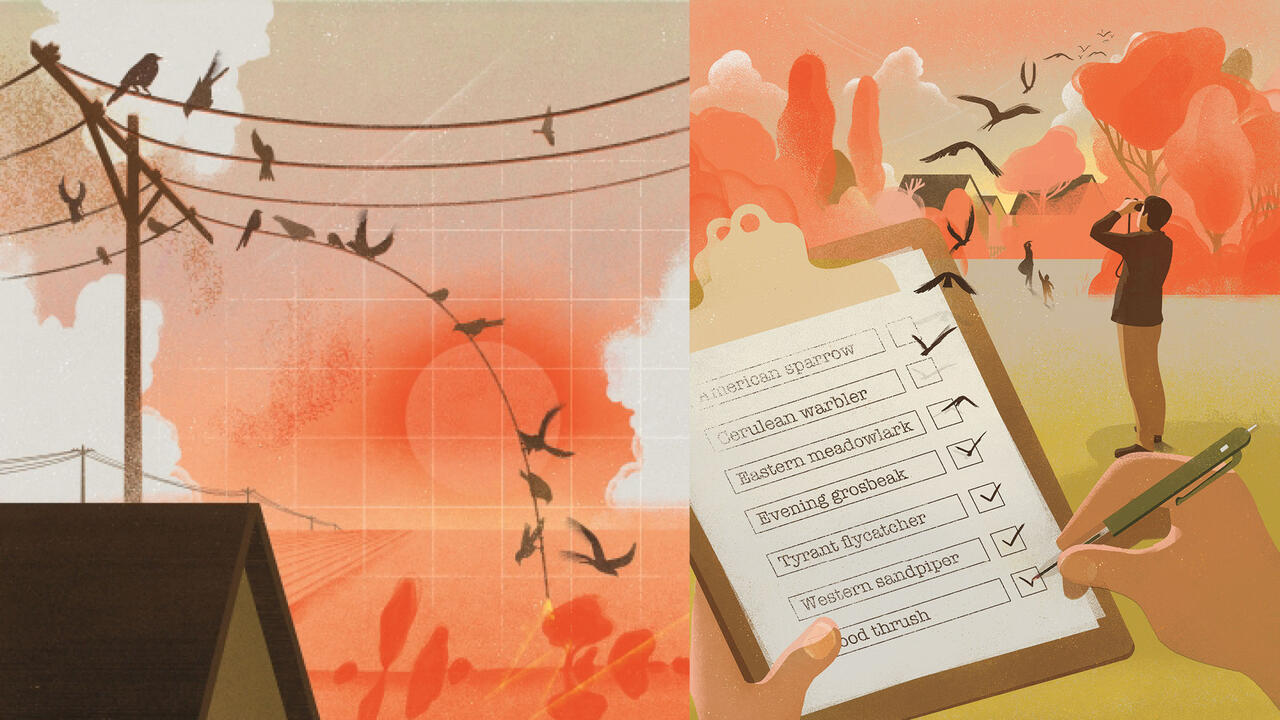Dawn Chorus Diminuendo: Confronting the Decline of North American Birds

Jessica Griffiths ’00 began her love affair with birds in the suburbs north of Chicago. “Our backyard backed up to a woodland,” she says. “The area was zoned as a flood plain, so it couldn’t be developed. It was a few acres of deciduous woodland. I would rush home from school—I was 14, mind you—and I’d get a pair of binoculars, I think they were from my grandpa. They were unbelievably heavy military binoculars. But that was what we had. And I would go out birding in those woods.”
When Griffiths got to Wellesley, she discovered a club called WABAN, which stood for Wellesley Amateur Bird-Watchers and Naturalists. WABAN’s faculty sponsor, Professor Emeritus of Biological Sciences Nicholas Rodenhouse, would become Griffith’s major advisor.
“When I was a sophomore, he asked me if I wanted a job. It was a summer internship working on his field research at Hubbard Brook in New Hampshire. It was bird work. I still remember him telling me about it, and me being like, ‘Wait, wait. Are you telling me you’re going to pay me to walk around in the forest and look at birds?’ After that summer, I knew, ‘Well, this is what I’m going to do now,’” Griffiths says.
It would be a peripatetic life. Now a biologist for a California environmental consulting firm, Griffiths spent the first few years after Wellesley traveling around the country working for nonprofits and government agencies in seven states, with a focus on songbird ecology and monarch butterfly migration. She worked as a wildlife biologist at the Big Sur Ornithology Lab, counted bird nests in Yosemite, and coordinated citizen scientists doing the annual Christmas Bird Counts sponsored by the Audubon Society.
“People have been talking about the extinction crisis, and we’ve seen rare species decline or go extinct. But when even our common species have declined so drastically, it’s very hard to imagine that there aren’t significant holes in the tapestry of our world and that at some point, it’s really going to fray.”
Carola Haas ’83, professor of wildlife ecology at Virginia Tech
So Griffiths was not surprised when Science magazine published a study titled “Decline of the North American Avifauna” in its Oct. 4, 2019, issue. Ken Rosenberg, a senior scientist at the Cornell Lab of Ornithology and the American Bird Conservancy, was the lead author, along with scientists from the National Wildlife Research Centre in Ottawa, the Canadian Wildlife Service, and others.
The laconic title notwithstanding, the article sounds an emergency call, revealing that the North American continent has lost nearly 3 billion birds across 529 species over the last 50 years. This means there are 29 percent fewer birds in the United States and Canada today than in 1970. Of the nearly 3 billion birds lost, 90 percent came from just 12 families, including familiar birds such as sparrows, warblers, finches, and swallows.
Interconnected factors are responsible for the decline. Agriculture and habitat loss are likely the primary causes, though climate change, declining insect populations, light pollution, glass window panes on buildings, and outdoor cats also play a role.
“One of the things that came out in this study is that the guild of birds that shows the most serious decline is grassland birds,” says Griffiths. “I did a summer internship in 1999 for the U.S. Geological Survey doing grassland bird surveys. At the research station I worked at, [we gathered] all kinds of information on how grassland birds were declining precipitously then, more than 20 years ago. So when this paper came out and I saw it, I was like, yup, they’re still in trouble.”
Carola Haas ’83, professor of wildlife ecology in the department of fish and wildlife conservation at Virginia Tech, wasn’t surprised by the Science article either. Haas’ research centers on wildlife populations in managed ecosystems, with a focus on breeding and movement behavior of amphibians, birds, and reptiles.
“It’s a very powerful paper,” Haas says. “It’s shocking in terms of the magnitude, but everybody had a sense that this was going on. But to be able to really quantify it in that way was different. You know, in certain political climates, nobody cares about these things, but it’s easier to make more effective arguments when you can quantify what’s happening.”
To arrive at the mind-boggling numbers, the authors of the study used on-the-ground tallies carried out over decades by amateur bird-watchers—including the annual North American Breeding Bird Survey and the Christmas Bird Count. Their observations provided a wealth of data that the researchers cross-referenced with information from 143 weather radars designed to detect rain but also discern biomass—the groups of hundreds of migratory bird species moving through the skies in fall and spring. Measurements revealed that the volume of spring migration has dropped 14 percent in the past decade.
“People have been talking about the extinction crisis, and we’ve seen rare species decline or go extinct,” says Haas. “But when even our common species have declined so drastically, it’s very hard to imagine that there aren’t significant holes in the tapestry of our world and that at some point, it’s really going to fray.”
This is an excerpt from an article by Catherine O’Neill Grace that appears in the spring 2020 issue of Wellesley magazine. Read the full story on the Wellesley magazine website.

